The Homeless Man Who Made Chimeras
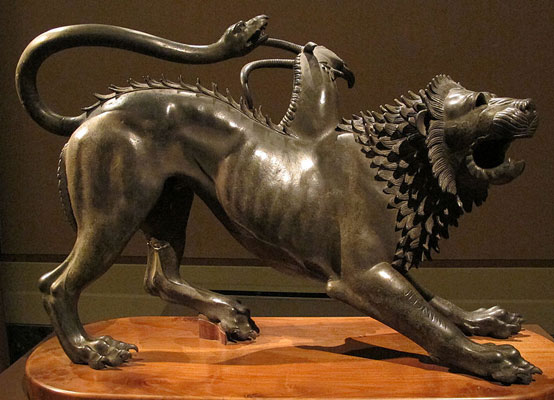
Chimera: accurate gene function measures call for disparate animal parts.
Source: I, Sailko
Curtain open
Why is the mouse such a laboratory darling? Is it because, being a mammal, it serves as a better model for human diseases when compared to non-mammals like flies and worms? It sure does. But then why not pigs, or cats? Why not Tom instead of Jerry? Well, mice procreate easily, have short generation times (spawning, for gamers), and are small so there's less space and less cost needed to house them. Add to that the fact that "the mouse carries virtually all genes that operate in the human"[1], and you can see why scientists like to "knock out" mice genes, or put in new ones, and see what an effect they'll have.
And an effect they do have. Take for example the PEPCK (no relation to Lewis C.K.) mouse that can run for 5 hours, live longer than a normal mouse, eat twice as much and weigh half as much, and engage in reproduction well after its whiskers have turned white. Not all mice get to live the good life in the lab, but I think these ones do.
One of the pioneers of gene targeting in mice was an Italian street urchin, who went on to share the Nobel Prize for his research on knocking out genes in mice. I believe this was a plan he hatched after swearing revenge against the mice that shared the streets with him and occasionally stole what little food he had, and generally pestered him, but I've been unable to find sources that back up this claim. Doesn't mean it's not true, though.

Mario Ramberg Capecchi: distinguished professor of human genetics at the School of Medicine, investigator at the Howard Hughes Medical Institute, distinguished professor of biology, Nobel Prize winner, and former homeless person wandering the streets of Italy. Here seen talking to his hand (presumably). Alternatively, he might be in the process of giving someone the Italian salute.
Source: Wikimedia Commons Contributors
Having established, in previous posts, that indigent children can win Nobel Prizes, and that researchers born to wealthy families also are not excluded from winning Nobel Prizes, it stands to reason that being both an aristocrat and poor will only double your chances of winning a Nobel Prize. Mario Capecchi appears to be a case in point, as you'll find out by reading on.
DNA immigrants
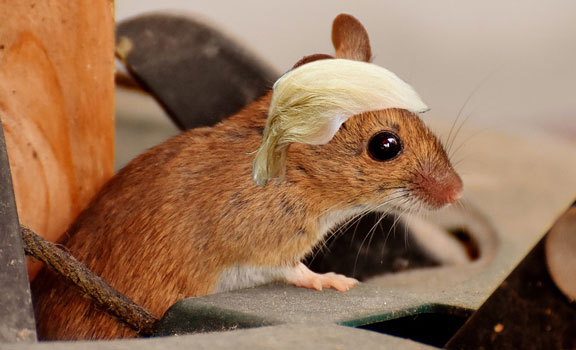
"They're bringing drugs. They're bringing crime. They're rapists. And some, I assume, are good genes."
Source: Michael Vadon & FreeGreatPicture, modified
In the 1960s, developments happened in biology that made Mouse Donald Trump cringe. Foreign DNA elements were casually introduced to otherwise pure mouse germ lines. These DNA elements, inserted into the pure line at random, didn't do much good. They brought with them drugs (markers to help biologists locate them afterwards), and they violated (raped) the normal DNA sequence. This was a crime against nature. Some genes, Mouse Trump assumed (correctly), were good genes that brought benefit to the mouse. But those were a minority.
Several methods had been devised to create these GMMs (genetically modified mice), but two stand out. One is pronuclear injection. This basically means literally injecting a mouse egg with sperm or any other foreign DNA. It requires steady hands (I assume), and it's done before the genetic material of the sperm and egg fuse. The rate of success varies, with about 10-40% of the mice born containing these new genes.[3]
The second approach, which Mario Capecchi partly pioneered, involved the use of embryonic stem cells.
Making Chimeras
This is the general recipe that Capecchi followed in making his chimeric mice:
Step 1
Get embryonic stem cells from a donor mouse that has a differently-colored coat from the recipient mouse. (The difference in coat-color is to make identification of successfully gene-targeted mice easier later.)
Step 2
If the goal is to create a knockout mouse, i.e. to remove rather than add a function ("knock out a gene"), then add a mutated non-functional copy of the gene to the embryonic stem cells. And also add a drug resistance marker for Step 4.
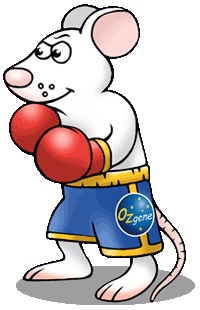
Source: Wikimedia Commons Contributors
Step 3
By a process called homologous recombination, genes that have similar (homologous) sequences will automatically swap (recombine). The process isn't yet completely understood, which is why biologist dads use it as an excuse to their yelling wives when they realize they've accidentally picked up the wrong kid from school. Hey, it happens.
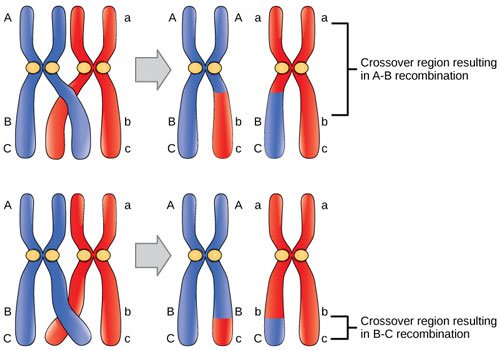
Source: Wikimedia Commons Contributors
Step 4
Not all genes will recombine. I.e. not all cells will incorporate the gene. So you add a drug that will kill any cells that have not incorporated the gene. How are you able to kill only those cells, and not the others? Well, the cells that have incorporated the mutant gene, have also incorporated the drug resistant marker. See Step 2.
Step 5
Take these cells that you've created, and transplant them into a mouse embryo that has (or would have) a different coat-color to the donor mouse. So if the donor mouse was black, the recipient mouse will be white. So this mouse will have some cells that are white-mouse cells, and some that are black-mouse cells. A chimeric mouse is easy to identify due to its bicolor nature.
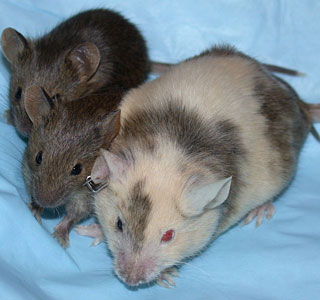
Source: Wikimedia Commons Contributors
Step 6
A chimeric white mouse might have some of those black undifferentiated embryo cells grow up to be reproductive cells. Or not. If yes, then if you mate a male chimeric mouse with a white female mouse, some of the pups will be black.
Step 7
It's simple good ol' Mendelian inheritance plug-and-play from here on out. Just breed the mice until you get pure knockout mice, or else just sequence their genomes.
Step 8
Now that you have your pure knockout mice, you can study what the absence of that gene does to them, and extrapolate to what the same gene might be doing in humans. For example they might knock out a suspected tumor-suppressing gene to see what that does to cancer growth. The PEPCK (no relation to Pepci-Kola, a Pepsi-Cola knock-off) mouse mentioned in the introduction is the result of altering a gene involved in glucose metabolism (which is why it's also called metabolic supermouse, or simply supermouse). (The PEPCK mouse is a knock-in mouse, not a knock-out mouse, but the principles governing their creation are analogous.)
Capecchi's life: from street urchin to researchin'
_-_n._2768_-_Scugnizzo_napoletano-.jpg)
Source: Wikimedia Commons Contributors, modified
Mario Capecchi's life is the stuff movies are made of. His Italian father died while manning an anti-aircraft gun in WWII. His American-born mother was sent to a concentration camp for pamphleteering and being a member of an anti-Fascist group in Italy. That was quite the new low for a woman who had grown with "[a] nanny, gardeners, cooks, house cleaners and private tutors for languages, literature and sciences"[9]. Anticipating her arrest, she made preparations by selling all her belongings and giving the money to a peasant family that would care for Mario. The dough, however, run out, so 4.5-year-old Mario was left to fend for himself. After 4 years and a 1-year search, his now-released aristocrat mother who spoke 15 languages managed to find him in a hospital, malnourished to the brink of death. They went to Rome where he had his first bath in 6 years.
His luck changed dramatically when his uncle, an American physicist who lived in the States, sent money to his sister to return to the US, to live with him and almost 65 other families in a utopian commune they had established near Philadelphia. From then on, it was one academic success after another for Capecchi: Bachelor of Science degree in chemistry and physics in 1961 from Antioch College in Ohio, physics and mathematics graduate student at MIT who later decides to switch to molecular biology and so transfers to Harvard to join the lab of James D. Watson, Ph.D. in biophysics in 1967 from Harvard University, and so on and so forth, culminating in the 2007 shared Nobel Prize in Physiology or Medicine, which, I can only assume (but can't prove), his old street gang friends from Italy helped him secure.
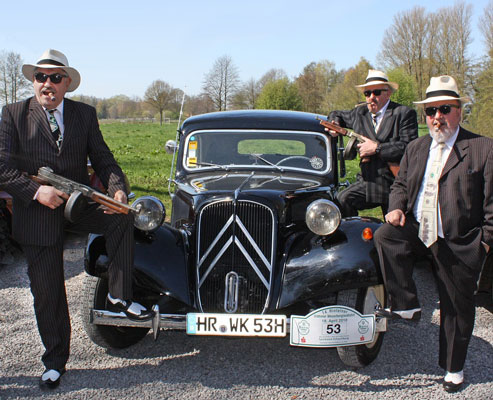
"Capecchi will get the Nobel Prize. Capisce?"
Source: FreeGreatPicture
One of the moments that defined Capecchi's career came in 1973, when he realized that "science was losing something"[9]. Scientists at the ~50 universities in the Boston area at the time where too focused on research that promised immediate gratification, questions that could be answered in 6 months, which led to short term gains but long term losses. He decided to relocate to the University of Utah in Salt Lake City, a place of relaxed atmosphere and relative isolation where he could work on projects that might bear fruit in only 10 years' time.
He slowly zeroed in on gene targeting as his research focus, and received funding despite the NIH's being skeptical that his work would be successful.
Curtain close
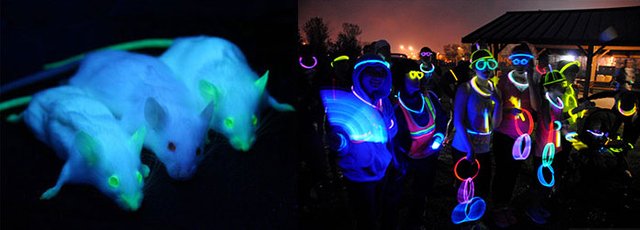
Mice genetically modified for partying. Will humans be next?
Source: Wikimedia Commons Contributors & http://www.grandforks.af.mil/, modified
Transgenic and knockout mice are invaluable genetic tools to model human diseases such as cancer. They are "the most accurate in vitro [sic, ought to be 'in vivo'] models available to researchers and facilitate the development of personalized drugs and diagnostics"[12]. The only reason it's possible to model human diseases using mice is because of our genetic and evolutionary relatedness to them.
Unlike many of the protagonists of my other posts, Capecchi is still alive at age 80. A result of his early childhood calorie restriction? Who knows.
Long-age is not the only facet of his success. Nor is it the most unlikely one: how could a child who never went to school, not even one under a tree, and who didn't speak a word of English, attain such an unlikely level of academic success? Could it be the education he received at his uncle's commune, where "high school kids were treated liked college students"[9]? Could it be that they "had a dialogue between teachers and students. There were no textbooks. It made learning enjoyable"[9]? Or was it the sense of social responsibility that was taught — or rather felt — there? "There was a cognizance of world problems. It wasn't taught, but it was felt that you could--you should--do something to make this a better world."[9] Could it be the fact that political conversations around the dinner table were not discouraged, but rather encouraged? Or was it that his uncle "used 'subliminal indoctrination' to persuade his nephew of the value of science"[9]? We are pattern-seeking organisms, which is what makes us good at science, but also what causes us to pay overmuch attention to mere circumstances. Unfortunately, we still don't know the recipe for success, which means we should spread opportunity as widely as possible. As Capecchi himself said in his Kyoto Prize address:
What I have learned from my own experiences is that the genetic and environmental factors that contribute to such talents as creativity are too complex for us to currently predict. In the absence of such wisdom, our only course is to provide all of our children, with ample opportunity to pursue their passions and their dreams. Our level of understanding of human development is too meager to allow us to foresee which of the children in our midst will be the next Beethoven, Modigliani or Martin Luther King.[13]
REFERENCES
1. Hofker, Marten H.; Deursen, Jan van (2002). Transgenic Mouse. Totowa, New Jersey: Humana Press. https://www.springer.com/us/book/9781592593408
2. Wikipedia contributors, "PEPCK-Cmus mouse," Wikipedia, The Free Encyclopedia, https://en.wikipedia.org/w/index.php?title=PEPCK-Cmus_mouse&oldid=811033539 (accessed March 1, 2018).
3. Wikipedia contributors, "Microinjection," Wikipedia, The Free Encyclopedia, https://en.wikipedia.org/w/index.php?title=Microinjection&oldid=812686879 (accessed March 1, 2018).
4. Kumar TR, Larson M, Wang H, McDermott J, Bronshteyn I. Transgenic Mouse Technology: Principles and Methods. Methods in molecular biology (Clifton, NJ). 2009;590:335-362. doi:10.1007/978-1-60327-378-7_22. https://www.ncbi.nlm.nih.gov/pmc/articles/PMC4095860/
5. The University of Utah. The Genetic Science Learning Center. Transgenic Mice. http://learn.genetics.utah.edu/content/science/transgenic/
6. Wikipedia contributors, "Genetically modified mouse," Wikipedia, The Free Encyclopedia, https://en.wikipedia.org/w/index.php?title=Genetically_modified_mouse&oldid=811610569 (accessed March 1, 2018).
7. Wikipedia contributors, "Homologous recombination," Wikipedia, The Free Encyclopedia, https://en.wikipedia.org/w/index.php?title=Homologous_recombination&oldid=828150071 (accessed March 1, 2018).
8. Wikipedia contributors, "Mario Capecchi," Wikipedia, The Free Encyclopedia, https://en.wikipedia.org/w/index.php?title=Mario_Capecchi&oldid=820973910 (accessed March 2, 2018).
9. The University of Utah. The Genetic Science Learning Center. Mario Capecchi, Ph.D. http://learn.genetics.utah.edu/content/science/capecchi/
10. Wikipedia contributors, "Gene knockout," Wikipedia, The Free Encyclopedia, https://en.wikipedia.org/w/index.php?title=Gene_knockout&oldid=818360999 (accessed March 2, 2018).
11. "The 2007 Nobel Prize in Physiology or Medicine - Press Release". Nobelprize.org. Nobel Media AB 2014. Web. 2 Mar 2018. http://www.nobelprize.org/nobel_prizes/medicine/laureates/2007/press.html
12. Wikipedia contributors, "Gene targeting," Wikipedia, The Free Encyclopedia, https://en.wikipedia.org/w/index.php?title=Gene_targeting&oldid=825019824 (accessed March 2, 2018).
13. Kyoto Prize Lecture. http://www.kyotoprize.org/en/laureates/mario_renato_capecchi/ & http://www.kyotoprize.org/wp/wp-content/uploads/2016/02/12kB_lct_EN.pdf
Earlier Introduction to Biology episodes:
16: What The Human Genome Project Discovered About Who We Are
15: The First Physically Mapped Human Gene
14: Sequencing DNA using Gel Electrophoresis
13: Cutting, Pasting, Cloning, and GMOs
12: How a Boy From an Indian Village Broke the Code of Life and Won the Nobel Prize
11: The Most Beautiful Experiment In Biology
10: The Great GATC-by: The Most Famous Science Paper of the 20th Century
9: The Great Kitchen Blender Experiments: How DNA was proved to be the seat of heredity
8: Finding, Counting, and Ordering Genes Using Incredibly Sophisticated Biomolecular Megatechnology
7: Christmas Disease — Yes, it's real, 100% scientifically proven!
6: The Most Famous All-Nighter in the History of Genetics
5: Mendel's Lucky Number Seven — The law of genetics that almost wasn't
4: How Cells Use Logic To Do The Impossible
3 : Armchair Science — The Discovery of Proteins' Secondary Structure
2 : How Cell Membranes Form Spontaneously
1 : Eduard Buchner: The Man Who Killed Vitalism
steemSTEM is the go-to place for science on Steemit. Check it out at @steemstem or browse the #steemSTEM tag or chat live on discord
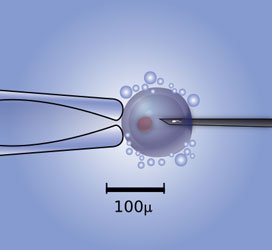
Being A SteemStem Member
You are a great writer and I enjoy reading your posts. Some typos and things you may want to consider:
Typo: They are "the most accurate in vitro..." This should read in vivo_
Cheers!
Love Genetics!
ian
This is what happens when you rely too much on wikipedia lol! And by you I mean I! The 'in vitro' part for instance is a direct quote. Since the animals are whole and living I guess it means you're right! Fixed.
About the PEPCK mouse, I wrote in the first paragraph ""knock out" mice genes, or put in new ones". But the second time I mention the mouse I leave room for confusion. I added a note.
I fixed the pronuclear injection thing, that was a mistake that I can't blame on anyone else unfortunately. :P
Thanks so much for taking the time to read attentively and comment!
My pleasure and I edited the Wikipedia entry.
I am partly and indirectly responsible for a two-letter change on Wikipedia.
I can now die happy.
Loved the post!! I didn't know they first made a chimera and then breed between them until they had a full knockout mice!
The life story of Mario Cappechi is amazing, it would be amazing to read his autobiography, do you know if such a thing exists?
Putting family guys video in your posts is a great idea, i might steal that one if you don't mind xD
This is what is wrong with nowadays teaching, they put us in a machine AKA school to pump out kids with the same characteristics... learning shouldn't be like this, we really need to evolve our education system, or at least the education system in my country, i've heard some of the northern European countries have a much better education system
No autobiography exists at the moment to my knowledge.
Use family guy as you like! )
Much wrong with the education system. I myself always hated school but loved uni, and I'm the kind of person who's been reading books my whole life, even when I was at school, I did as little homework as possible so I could read! So yeah there's plenty that needs rethinking in that area.
I always check your posts for great science and even better laugh, and never regret it! :)
I had a dog who was both black and white. A chimeric dog maybe ;)
And to find out, why Donald Mice has a toupee like that, just google golden ratio. Haha. (or check my post ;) haha, not doing post promotion but this was brought to my attention in the comments of the said post, also the post is 10 days old ;))
Capecchi, The guy that confirms that illuminati is real.
Haha, Jokes aside, this was very interesting as well as intriguing post. I thoroughly enjoyed every sentence, every line of this post. You killed(raped ;)) it.
P.S. (Edited) Found out you'd already visited the post. And also saw your comment. ;)
The nobel prize commission has long been in the pocket of the Mafia. I'm sure of it.
Great article as a whole. This is one facet of genetic history that I wasn't too familiar with so its great to learn it.
This post is a sheer delight. Only thing is, I do feel sorry for the mice. I know that's not scientific, but I can't help it. Your point at the end is brilliantly relevant. Everybody deserves the best education. It's folly to think we can identify talent or a lack of talent in a child. And think of all the children who don't have the opportunity to exploit whatever natural resources nature gave them, merely because they were born in the wrong place. Their loss, our loss. I'm following you and sharing on Twitter.
Being compassionate toward creatures that possess consciousness and can therefore suffer, especially when we're the ones causing the suffering — that's only human, and definitely not not-science. But between suffering mice and suffering relatives (and suffering self), I'd choose the former. Hopefully in the future we won't need to make that choice.
Followed back, thanks for the follow and the share and the reading!
Let's make mice great again?
They are already great, even though they are small. Don't be a sizeist.
Very detailed post with references.
Well done!